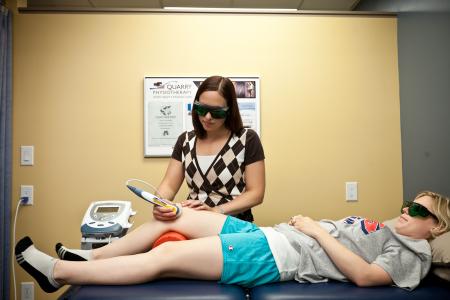What is a Laser?
LASER is an acronym for Light Amplification by Stimulated Emission of Radiation
A beam of focused light energy converted into chemical energy resulting in accelerated tissue repair and pain control.
What are the Laser Affects?
Laser is a form of electromagnetic energy to create physiological changes within the body...
- Reduction in inflammation and swelling
- Increase in speed, quality and strength of tissue repair by stimulating collagen synthesis and accelerating cellular reproduction and growth
- Reduces fibrous tissue formation (scarring)
- Increases vascular and lymphatic activity as well as angiogenesis (formation of new blood vessels)
- Increases serotonin metabolism and increases circulating endorphins creating an analgesic affect (pain reduction)
Conditions Treated
Laser is used for many musculoskeletal conditions...
- Arthritis
- Sports injuries
- Work / MVA injuries
- Back / neck injuries
- Neuralgia, nerve pain, carpal tunnel syndrome
- Tendonitis, bursitis, sprains and strains
- Post surgical / fracture stiffness
- Fibromyalgia / trigger points
- Repetitive motion injuries
- Headaches, TMJ
Is Laser Safe?
Laser is very safe, evidence based with very few contraindications for use. Hundreds of double blind studies have proven the efficacy of laser over the past 30 years.
Laser should be avoided with Cancer, photosensitivity, over the abdomen during pregnancy and over pacemakers.
What does a procedure involve?
A Laser treatment involves evaluating the area to be treated, cleaning the skin, applying protective eye lenses and then applying the laser to the tissue.
Typically there is no sensation other than slight warmth. A treatment may last anywhere from 1 - 5 minutes depending on the area treated and the size of the laser applicator.
Fees / Cost
No additional costs are incurred. Laser is incorporated as part of the regular Physiotherapy Assessment or treatment.
Laser only treatments may be prescribed in certain conditions. Fees are determined on an individual basis.
How does a Laser work?
- Pumping of atoms inside an enclosed tube excites electrons causing them to move to higher energy levels.
- Mirrors on each end of the tube cause a ping pong effect resulting in electrons to move to lower energy levels.
- As electrons return to lower energy levels light energy is emitted at the same frequency producing "laser energy".
What are the Characteristics of Laser?
Monochromatic
- Refers to light purity
- One wavelength, color and frequency
Coherent
- All light wavelengths are in phase matching identically in timing and spacing
Collimated
- Light (photons) is extremely focused with negligible divergence and remains so during tissue penetration
- High degree of directionality
What are the different types of Lasers used in musculoskeletal conditions?
Infrared (Diode Laser)
- 700-1000 nanometers (nm) in wavelength
- Deepest penetration 30-50mm
- Collimated, coherent and monochromatic properties
- Used at Quarry Physiotherapy
Visible Red
- 600-700 nm
- Superficial treatment only (skin) 3-4mm penetration
Light Emitting Diode (LED)
- 600-700 nm
- Non-collimated (less focused)
- Superficial treatment only
Superluminous Diode (SLD)
- Non-coherent, not one color, more focused then LED
- Can be any wavelength
- Depth of penetration more than LED, less than infrared



